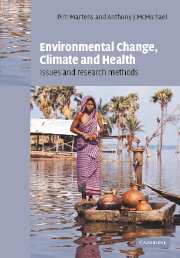Book contents
- Frontmatter
- Contents
- List of contributors
- Foreword
- 1 Global environmental changes: anticipating and assessing risks to health
- 2 Historical connections between climate, medical thought and human health
- 3 The contribution of global environmental factors to ill-health
- 4 Surprise, nonlinearity and complex behaviour
- 5 Epidemiological and impacts assessment methods
- 6 Retrospective studies: analogue approaches to describing climate variability and health
- 7 Detecting the infectious disease consequences of climate change and extreme weather events
- 8 Integrated Assessment modelling of human health impacts
- 9 Remote sensing, GIS and spatial statistics: powerful tools for landscape epidemiology
- 10 Monitoring the health impacts of global climate change
- 11 Epidemiology, environmental health and global change
- 12 Dealing with scientific uncertainties
- Index
- Plate section
- References
5 - Epidemiological and impacts assessment methods
Published online by Cambridge University Press: 28 July 2009
- Frontmatter
- Contents
- List of contributors
- Foreword
- 1 Global environmental changes: anticipating and assessing risks to health
- 2 Historical connections between climate, medical thought and human health
- 3 The contribution of global environmental factors to ill-health
- 4 Surprise, nonlinearity and complex behaviour
- 5 Epidemiological and impacts assessment methods
- 6 Retrospective studies: analogue approaches to describing climate variability and health
- 7 Detecting the infectious disease consequences of climate change and extreme weather events
- 8 Integrated Assessment modelling of human health impacts
- 9 Remote sensing, GIS and spatial statistics: powerful tools for landscape epidemiology
- 10 Monitoring the health impacts of global climate change
- 11 Epidemiology, environmental health and global change
- 12 Dealing with scientific uncertainties
- Index
- Plate section
- References
Summary
Introduction
Future global environmental exposures may be significantly different from those experienced in the past. Forecasting and preparing for the resultant potential ecological, social and population health impacts requires innovative and interdisciplinary research approaches, both to advance global change/health science and to contribute to informed policy decisions. These approaches include empirical analyses and scenario-based exposure modelling to achieve meaningful risk assessments of the potential impacts of climate and ecological changes. This chapter focuses on the application of epidemiology (an empirically based discipline) to understanding the potential health consequences of global environmental change. The empirical knowledge gained from epidemiological studies should be used iteratively with model development to strengthen the foundation of predictive models.
Epidemiological research can be used in the three domains introduced in Chapter 1: first, historical analogue studies to help understand current vulnerability to climate-sensitive diseases (including contributions to understanding the mechanisms of effects) and to forecast the health effects of exposures similar to those in the analogue situation; second, studies seeking early evidence of changes in health risk indicators or health status occurring in response to actual environmental change; and third, using existing empirical knowledge and theory to develop empirical-statistical or biophysical models of future health outcomes in relation to defined scenarios of change. This chapter discusses some standard epidemiological methods used to generate quantitative estimates of exposure–disease associations for studies in these three domains. The examples focus primarily on climate variability and change to maintain consistency throughout the discussion.
- Type
- Chapter
- Information
- Environmental Change, Climate and HealthIssues and Research Methods, pp. 120 - 143Publisher: Cambridge University PressPrint publication year: 2002
References
- 1
- Cited by



